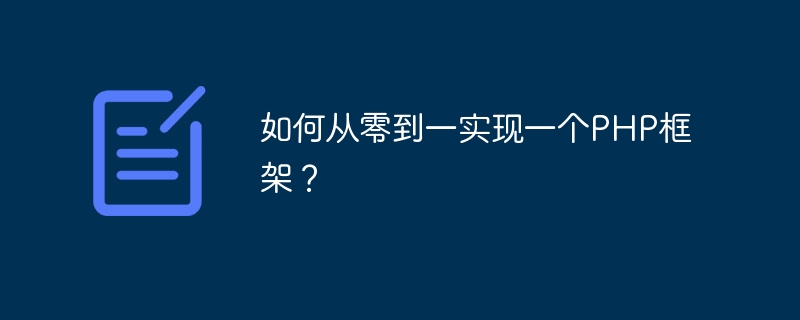

How to implement a PHP framework from scratch?
Introduction:
PHP is a powerful server-side scripting language that is widely used in web development. The PHP framework can help developers simplify the development process, improve development efficiency, and provide reusable code modules. This article will introduce how to implement a simple PHP framework from scratch to help readers understand the basic concepts and core functions of the framework.
1. Understand the concept of framework
Before implementing a PHP framework, we need to understand the concept and basic principles of the framework. A framework is a structured development environment that defines a series of specifications and conventions to help developers develop applications more efficiently. Common PHP frameworks include Laravel, Symfony, etc., which provide a series of tools and components for handling common development tasks such as routing, database, and user authentication.
2. Preparation work
Before we start to implement our PHP framework, we need to prepare the following work:
3. Create project directory structure
Our framework requires a clear directory structure so that developers can easily organize and manage code. The following is a simple directory structure example:
- app - controllers // 控制器目录 - models // 模型目录 - views // 视图目录 - config // 配置文件目录 - core // 框架核心目录 - public // 公共资源目录(入口文件index.php所在的目录)
In the config directory, we can store some framework configuration files (such as database connection configuration and routing configuration, etc.). In the core directory, we will implement the core functions of the framework (such as routing management and request processing, etc.). In the public directory, we store some public resources (such as CSS and JavaScript files).
4. Define routing rules
Routing is a very important concept in the framework, which determines which method or controller the request should be processed by. We can determine routing rules by parsing the path in the URL. The following is a simple routing example:
// 获取请求的路径
$url = $_SERVER['REQUEST_URI'];
// 根据路径来决定路由规则
// 比如 /product/show/1 应该由 ProductController 中的 show 方法处理
if($url == '/product/show/1') {
$controller = new ProductController();
$controller->show();
}In actual development, we can match different URL paths through regular expressions and pass the matching parameters to the corresponding methods or controllers.
5. Implement the MVC pattern
MVC (Model-View-Controller) is a common architectural pattern used to separate the logic, data and user interface of the application. In our framework, we can also implement a simple MVC pattern.
6. Implement automatic loading of classes
In the framework, we may use many classes to implement various functions. To avoid manually introducing each class file, we can implement an autoloading class. The following is a simple implementation of automatically loading classes:
spl_autoload_register(function($className) {
$className = str_replace('\', '/', $className);
require_once __DIR__ . "/$className.php";
});By converting the class name into a file path, we can automatically load the corresponding class file.
7. Implement core functions
In the core directory, we can implement some core functions, such as routing management and request processing. The following is an example of a simple framework core class:
class Framework {
public function run() {
// 解析URL路径,决定路由规则
// 根据路由规则调用相应的方法或控制器
}
}In the run method, we can complete functions such as route parsing and request processing.
8. Summary
Through the above steps, we have implemented a simple PHP framework from scratch. Of course, this is just a simple example, and actual framework development may require more features and extensions. I hope this article can help readers understand the basic concepts and implementation principles of the PHP framework, so that they can better apply and expand the framework in actual development.
The above is the detailed content of How to implement a PHP framework from scratch?. For more information, please follow other related articles on the PHP Chinese website!




